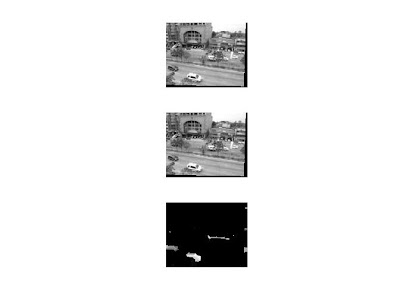IM2 = imdilate(IM,SE) dilates the grayscale, binary, or packed binary image
IM, returning the dilated image,
IM2.
IM2 = imerode(IM,SE) erodes the grayscale, binary, or packed binary image
IM, returning the eroded image
IM2.The argument
SE is a structuring element object or array of structuring element objects returned by the
strel function.
The morphological
close operation is a dilation followed by an erosion, using the same structuring element for both operations. The morphological
open operation is an erosion followed by a dilation, using the same structuring element for both operations.
these operations are performed on a stabilized video sequence done by SIFT. and basic background subtraction. se1 = strel('square',11) % 11-by-11 square
se2 = strel('line',10,45) % line, length 10, angle 45 degrees
se3 = strel('disk',15) % disk, radius 15
se4 = strel('ball',15,5) % ball, radius 15, height 5

sedisk = strel('square',10);
fg = imclose(fg, sedisk);


sedisk = strel('line',10,90);
fg = imclose(fg, sedisk);
sedisk = strel('line',15,5);
fg = imclose(fg, sedisk);


sedisk = strel('disk',10);
fg = imclose(fg, sedisk);
 Deciding on the morphological structure is much harder than deciding on the threshold of background subtraction
Deciding on the morphological structure is much harder than deciding on the threshold of background subtraction
 frames = {avi.cdata}; %uses the cdata from the video file
frames = {avi.cdata}; %uses the cdata from the video file











